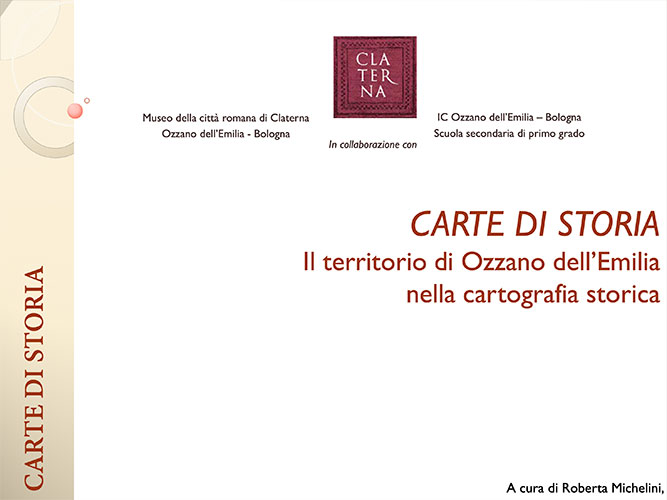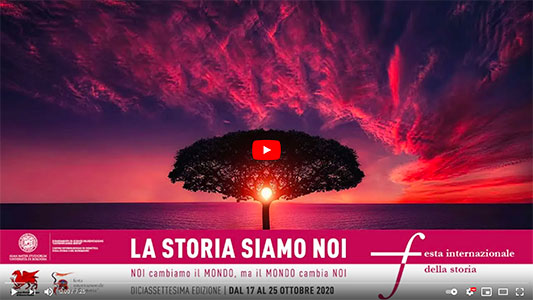DISCOVER THE SURROUNDINGS
Map of the territory in the Middle Ages
Claterna – Ulzianum – Ozzano. Ozzano dell’Emilia in the Middle Ages
The project
In spring 2019, the Museum of the Roman City of Claterna and the Comprehensive Institute of Ozzano dell’Emilia participated in co-partnership to the call “Io Amo i Beni Culturali” of the Emilia Romagna Region, presenting a didactic project for the study of the Ozzano territory during the medieval age. The project was funded by the Cultural Heritage Institute of the Region and, in the 2019-2021 school years, despite the difficulties that intervened during the course of the project due to the health emergency and the readjustments that had to be made in order to be able to work even remotely, the project was undertaken and continued, involving the fifth classes of the primary school and the first and second classes of the secondary school.
The enormous amount of work done by the students has resulted in a digital product that now accompanies the museum visitor, both in presence and at a distance, in learning not only about città romana di Claterna, to which the museum is dedicated, but also about the rich history of its territory. This product is divided into three moments: daily life in the city of Claterna, animated by the drawings of fifth grade students; the map of the territory, illustrated by the cards drawn up by students of the first classes of the secondary school; the gallery of historical maps, animated by the explanations of students of the second classes of the secondary school.
All this does not want to be exhaustive of the historical richness of Ozzano dell’Emilia: it wants to be an invitation to discover and observe it also walking among hills and torrents.
Download the document “Carte di Storia”.
The City of Claterna
Claterna was the main settlement in the Ozzano area during the whole Roman age; its abandonment at the beginning of the Middle Ages (6th century A.D.) accompanied a series of transformations that deeply modified the local population. This territory expressed all the types of settlement known for the Middle Ages and was organised both as a civil reality (curiae) and as a religious reality (plebanati). Large portions of the Ozzano territory, both hills and plains, were affected in the early Middle Ages by the presence of the masse, large rural estates that soon disappeared from written documents to give way to a fragmentation of settlement types created to meet the new needs that medieval culture elaborated: churches with different functions (parish churches and parishes), monasteries and abbeys, hospitals; villages and castles.
The two pievi, the one of Pastino in the hills and the one of Claterna in the plains, became a single entity in the late Middle Ages, but left vital local structures under religious management, such as the hospitals, intended to welcome and assist travellers and the needy; numerous parishes reached out to every part of the territory to meet the needs of all, and the monasteries of Settefonti and Monte Armato represented very important economic realities even beyond the local borders. It is to one of the abbesses of Settefonti, Lucia, that the most famous festival in Ozzano is still dedicated.
The tendency to the hierarchisation of settlements, which was certainly earlier in the religious sphere, from the late Middle Ages became evident also in the civil sphere, when the castle of S. Pietro di Ozzano emerged as an important political reality through the nobiles viri who lived there; but the diffusion of the settlement is evident if we count the large number of curiae recorded in the tax lists and which left traces also in the place names, often very well-known (Clagnano, Septefonti, Ulziani, Montisarmati).
CREDITS.The historical cartographic sources and the images of Claterna, included in the papers, are published with the authorisation of the following Authorities:
Ministry for Cultural Heritage and Activities and Tourism, Soprintendenza Archeologia, Belle Arti e Paesaggio for the metropolitan city of Bologna and the provices of Modena, Reggio Emilia e Ferrara;
reproduction prohibited for profit, including indirect profit (www.archeobologna.beniculturali.it)
Disegni da Claterna; Map of the Territory, card “Claterna”.
Ministry for Cultural Heritage and Activities and Tourism, State Archives of Bologna;
reproduction prohibited for profit, including indirect profit (as-bo@beniculturali.it)
Carte di Storia, cards nn. 2, 3 e 5; Map of the Territory, card “Massa delle Rapi”
The Public Library of the Archiginnasio of Bologna (archiginnasio@comune.bologna.it)
Map of the Territory, cards “S. Maria della Quaderna”, “S. Stefano in Claterna”, “Claterna”, “S. Andrea”, “S. Pietro di Ozzano”, “Pastino”, “Ciagnano”, “S. Cristoforo”
Emilia-Romagna Region, Geoportale (https://servizimoka.regione.emilia-romagna.it/mokaApp/apps/CST1H5/index.html)
Carte di Storia, scheda n. 4; Map of the Territory, cards “Monastero di Settefonti”, “S. Maria di Settefonti”, “Abbazia di Monte Armato”
Italian Military Geographical Institute (www.igmi.org)
Carte di Storia, card n. 1: From the Military Geographical Institute, authorisation n. 7072 del 26.02.2021
Group for the Enhancement of the Cultural Heritage of the Sillaro Valley of Castel San Pietro Terme (Bo)
Carte di Storia, card n. 6




